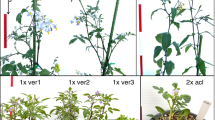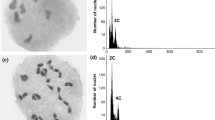Summary
The gene frequency for parallel spindles (ps) was estimated from the frequency of plants producing 2n pollen in three cultivated groups: 2x Phureja (phu), 2x Stenotomum (stn), and 4x Andigena (adg), as well as in four related wild taxa: 2x Solanum brevicaule (brc), 2x S. sparsipilum (spl), 4x S. gourlayi (grl) and 4x S. gourlayi-S. infundibuliforme hybrids (grl-ifd). Plants with more than 1% large pollen were considered as 2n pollen producers. Observations of meiosis in a sample of 2n pollen-producing plants indicated that parallel spindles is the mechanism of 2n pollen formation. The number of plants with 2n pollen among the total examined was 228 plants (15.5%) of 1,473 in 2x spl, 31 (26.7%) of 116 in 2x brc, 92 (17.4%) of 528 in 2x stn, 665 (22.1%) of 3,008 in 2x phu, 731 (51.4%) of 1,421 in 4x adg, 591 (41.2%) of 1,436 in 4x grl, and 36 (64.3%) out of 56 in 4x grl-ifd. The ps gene frequencies assuming Hardy-Weinberg equilibrium were: 0.393 for 2x spl, 0.462 for 2x brc, 0.417 for 2x stn, 0.470 for 2x phu, 0.847 for 4x adg, 0.801 for 4x grl, and 0.895 for 4x grl-ifd. Twenty-five adg clones were randomly selected from a large population and were crossed with 2x clone W5295.7, which produces 2n pollen by parallel spindles (ps). The 4x progenies from 4x×2x crosses were used to determine the genotypes at the ps locus by screening 10–20 plants in each family for 2n pollen. Based on chromosome segregation at the ps locus, 9, 14, 1, and 1 clones were nulliplex, simplex, simplex or duplex, and duplex, respectively. The frequency of the ps gene in the adg population was estimated to be 0.825 and 0.815 for chromosome and chromatid segregation, respectively. The high frequencies of 2n pollen and the ps gene in cultivated 2x and 4x groups, and in wild taxa closely related to them, provide evidence for sexual polyploidization in the tuber-bearing Solanums.
Similar content being viewed by others
References
Camadro EL, Peloquin SJ (1980) The occurrence and frequency of 2n pollen in three diploid Solanums from northwest Argentina. Theor Appl Genet 56:11–15
Cribb PJ, Hawkes JG (1986) Experimental evidence for the origin of Solanum tuberosum subspecies andigena. In: D'Arcy WG (ed) Solanaceae — biology and systematics. Columbia University Press, New York, pp 383–404
De Wet JMJ (1980) Origins of polyploids. In: Lewis WH (ed) Polyploidy — biological relevance. Plenum Press, New York, pp 3–16
Grun P (1979) Evolution of the cultivated potato: A cytoplasmic analysis. In: Hawkes JG, Lester RN, Skelding AD (eds) The biology and taxonomy of the solanaceae. Academic Press, New York, pp 655–665
Hawkes JG (1956) Taxonomic studies on the tuber-bearing Solanums. 1. Solanum tuberosum and the tetraploid species complex. Proc Linn Soc London 166:97–144
Hawkes JG (1978) Biosystematics of the potato, In: Harris DM (ed) The potato — scientific basis for improvement. Chapman and Hall, London pp 15–69
Hawkes JG (1979) Evolution and polyploidy in potato species. In: Hawkes JG, Lester RN, Skelding AD (eds) The biology and taxonomy of the solanaceae. Academic Press, London, pp 637–645
Hermundstad SA (1986) Haploid wild species hybrids in potato breeding, genetics, and germplasm enhancement. PhD Thesis, University of Wisconsin, Madison, pp 165
Höglund M (1970) Meiosis in Solanum phureja. Hereditas 66:183–188
Iwanaga M (1984) Discovery of a synaptic mutant in potato haploids and its usefulness for potato breeding. Theor Appl Genet 68:87–93
Iwanaga M, Peloquin SJ (1979) Synaptic mutant affecting only megasporogenesis in potatoes. J Hered 70:385–389
Iwanaga M, Peloquin SJ (1982) Origin and evolution of cultivated tetraploid potatoes via 2n gametes. Theor Appl Genet 61:161–169
Johnston SA, Rhude RW, Ehlenfeldt MK, Hanneman RE Jr (1986) Inheritance and microsporogenesis of a synaptic mutant (sy-2) from Solanum commersonii Dun. Can J Genet Cytol 28:520–524
Jongedijk E (1985) The pattern of megasporogenesis and megagametogenesis in diploid Solanum species hybrids: Its relevance to the origin of 2n eggs and the induction of apomixis. Euphytica 34:599–611
Lamm R (1945) Cytogenetic studies in Solanum sect. Tuberarium. Hereditas 31:1–128
Lamm R (1953) Investigation on some tuber-bearing Solanum hybrids. Hereditas 39:97–112
Masutani T (1962) Cytogenetic studies of the tuber-bearing Solanum species. 2. On the tetraploid species and an artificial octoploid plant in the series Longipedicellata Buk. Sci Rep Fac Agric Hokkaido Univ 41:79–82
Matsubayashi M (1981 a) Cytological mechanism for the formation of 2n pollen grains in tuberous Solanums. Potato Sci 1:29–34
Matsubayashi M (1981 b) Species differentiation in tuberous Solanum and the origin of cultivated potatoes. Recent Plant Breed 22:86–106
McHale NA (1983) Environmental induction of high frequency 2n pollen formation in diploid Solanum. Can J Genet Cytol 25:609–615
Mok DWS, Peloquin SJ (1975 a) Three mechanisms of 2n pollen formation in diploid potatoes. Can J Genet Cytol 17:217–225
Mok DWS, Peloquin SJ (1975 b) The inheritance of three mechanisms of diplandroid (2n pollen) formation in diploid potatoes. Heredity 35:295–302
Nijs TPM den, Peloquin SJ (1975 b) 2n gametes in potato species and their function in sexual polyploidization. Euphytica 26:585–600
Okada KA (1974) Colección de Solanum tuberiferos de Argentina. Lista de Semillas No. 3. INTA, Balcare, Argentina
Okwuagwu CO (1981) Phenotypic evaluation and cytological analysis of 24-chromosomal hybrids for analytical breeding in potato. PhD thesis, University of Wisconsin, Madison pp 170
Parrot WA, Hanneman RE Jr (1988) Megasporogenesis in normal and a synaptic mutant (sy-2) of Solanum commersonii Dun. Genome 30:536–539
Parrot WA, Smith RR (1986) Recurrent selection for 2n pollen formation in red clover. Crop Sci 26:1132–1135
Quinn AA, Mok DWS, Peloquin SJ (1974) Distribution and significance of diplandroids among the diploid Solanums. Am Potoato J 51:16–21
Ramanna MS (1974) The origin of unreduced microspores due to aberrant cytokinesis in the meiocytes of potato and its genetic significance. Euphytica 23:20–30
Ramanna MS (1979) A reexamination of the mechanism of 2n gamete formation in potato and its implication for breeding. Euphytica 28:537–561
Ramanna MS (1983) First division restitution gametes through fertile desynaptic mutants of potato. Euphytica 32:337–350
Souter EW, Dawe JC, Peloquin SJ (1980) 2n pollen formation via parallel spindles in the potato cultivar Sebago. Am Potato J 57:449–455
Stelly DM, Peloquin SJ (1986) Formation of 2n megagametophytes in diploid tuber-bearing Solanums. Am J Bot 73:1351–1363
Swaminathan MS (1954) Nature of polyploidy in some 48 chromosome species of the genus Solanums. Am J Bot 73:1351–1363
Swaminathan MS (1954) Nature of polyploidy in some 48 chromosome species of the genus Solanum, section Tuberarium. Genetics 39:59–76
Swaminathan MS, Magoon ML (1961) Origin and cytogenetics of the commercial potato. Adv Genet 10:217–256
Watanabe K (1988) Occurrence, frequency, cytology and genetics of 2n pollen; and sexual polyploidization in tuber-bearing Solanums. PhD Thesis, University of Wisconsin, Madison, pp 267
Werner JE, Peloquin SJ (1987) Frequency and mechanisms of 2n egg formation in haploid Tuberosum wild species F1 hybrids. Am Potato J 64:641–654
Yerk GL, Peloquin SJ (1988) 2n pollen in eleven 2x, 2 EBN wild species and their haploid-wild species hybrids. Potato Res 31:581–589
Author information
Authors and Affiliations
Additional information
Communicated by K. Tsunewaki
Paper No. 3032 from the Laboratory of Genetics. Research supported by the College of Agriculture and Life Sciences; International Potato Center; USDA, SEA, CGRO 84-CRCR-1-1389; and Frito Lay, Inc.
Rights and permissions
About this article
Cite this article
Watanabe, K., Peloquin, S.J. Occurrence of 2n pollen and ps gene frequencies in cultivated groups and their related wild species in tuber-bearing Solanums . Theoret. Appl. Genetics 78, 329–336 (1989). https://doi.org/10.1007/BF00265292
Received:
Accepted:
Issue Date:
DOI: https://doi.org/10.1007/BF00265292




